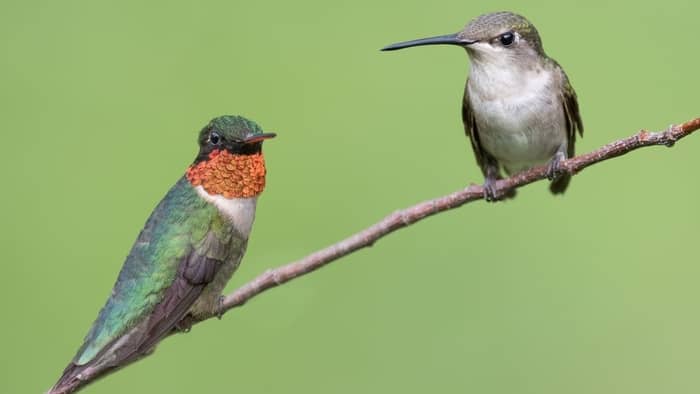Hummingbirds are beautiful creatures to behold especially when you have them coming to your yard in numbers to feed. It’s amazing to watch them flit around feeders, trying to get a spot for feeding or running after one another. While watching these creatures, one might be thinking; about how to tell the hummingbird gender.
One might think identifying the male hummingbird from the female hummingbird isn’t such a difficult thing. All you need to do is to look closely. Take a good look at the color.
Becoming a pro hummingbird watcher is not an impossible task. There are noticeable differences in the male and female hummingbirds that can never be missed. They are size, appearances, sounds, roles when it comes to breeding and behaviors.
So, in this article, we will be looking at the steps to take to help with how to tell hummingbird gender.
How To Tell The Difference Between Male And Female Hummingbirds: Identification Guides
Hummingbirds are sexually dimorphic creatures i.e. it is easy to tell a male hummingbird from a female hummingbird through appearance.
However, identifying the gender of the hummingbird entails more than ordinary looks. More on how to identify male hummingbirds from female hummingbirds will be discussed further.
So, let’s dive into the details.

1. Body Size
Females carry the eggs and lay eggs and they are to sit on the eggs to keep them warm. Their body size needs to be structured in a way to be able to undergo this process. That is why the female hummingbird is bigger in body size than the male.
The difference in body size of the male and female hummingbird may be fairly easy to tell actually. Let’s take a look at it this way; the weight of the female is usually between 2.8 and 4.5 grams. But the weight of the male is between 2.4 and 3.6 grams.
2. Appearance
Another way of how to tell the hummingbird gender is the color of their feathers and how bright they are. Usually, the male hummingbirds have bright feathers that they display to entice females and to show superiority and dominance to other males.
They also usually have brightly-colored feathers on the necks of male hummingbirds known as gorgets also attract females. The various colors of the gorget can be red, blue, orange, purple, and pink. The beauty of the gorget shows more when the sunlight shines on it.
On the other hand, the female doesn’t have bright-colored feathers. The females usually have dull feathers and they may be dull green, brown, and so on.
The younger male hummingbirds don’t usually have bright-colored feathers yet. They have dull feathers, thereby looking like the females.

3. The Sounds
In order to impress female hummingbirds and by so doing find a mate, the male hummingbird bird will begin to play with chirpy sounds. They also prove that they can make the loudest humming sound. They do this by going about flapping their wings very fast. It’s really amusing to watch. This is why they are known as hummingbirds.
The female hummingbirds enjoy listening to this show of orchestral display from the male. Even to the extent of sitting and closing their eyes to enjoy every bit of the show. The female finds the loudest sounds very attractive.
The female hummingbirds don’t need to show any skills or impress the female during mating. The only time the females make the same sounds just like the male is when they are protecting their nest and food source.
They do this by flapping their wings fast. They make raspy calls, sharp chirps, and trills when they want to be aggressive.
4. Roles When It Comes To Breeding
How to tell hummingbird gender is not a hard task during mating. The male hummingbird usually displays different dance steps to gain the female’s attention.
After mating both the male and female will go their separate ways. The female then goes ahead to build a nest. Now it’s the role of the female to care for and bring up its offspring by itself.
5. Behavior Pattern
The male hummingbird exhibits more aggressive behavior than the female. The male is way more aggressive. This behavior is being used by the male to attract the female.
And also, the male hummingbird attracts females or contends with other males by making so much scratchy chirping.
Another behavioral pattern is when the temperature drops way too low; it is time for hummingbirds to migrate to regions with warmer ambient and temperature.
They go all the way for more than 2000 miles to where will be convenient to mate. It’s been proven to an extent that the males are usually the first to migrate before the females.

Difference In The Appearance Of The Male And Female Hummingbirds Of Various Species
Let’s take a look at how to differentiate the male hummingbird bird from the female of different species.
Therefore, differentiating females of different species shouldn’t be so hard. So, let’s pick some common species of hummingbird and look at their differences:
·Difference Between The Ruby-Throated Male And Female Hummingbird
The male Ruby-throated hummingbird has an iridescent red throat. It has brighter green feathers on its back and also has a more grayish-white belly. On the other hand, the females are not as bright as the males.
Their throats and bellies are white. The green feathers on their backs are dull but the crown is more brownish instead of green.
·Difference Between The Male and Female Rufous Hummingbird
The male Rufous Hummingbirds have bright orange backs and bellies with a white patch beneath the chin. They also have bright reddish-orange iridescent throats. The female Rufous Hummingbirds have greenish-brown feathers on their backs.
They have whitish bellies and but their sides are pale and rusty in color.

·Difference Between The Male And Female Anna’s Hummingbird
The male Anna’s Hummingbirds throats’ are iridescently reddish-pink while the female’s throats are gray with a few red spotting.
What Is The Ratio Of Male To Female Hummingbirds
Most times in the eastern part of the U.S, younger Ruby-throated males are more in population than the younger females by a ratio of 3:2. And Ruby-throated is the most common species of hummers.
This can only imply that the high population of hummingbirds with white throats is mostly not female. They are immature male hummingbirds.
Why Do I Never See Male Hummingbirds?
So, from the hummingbird’s ratio to the male and female explanation above, we can deduce the answers to your question of why male hummingbirds are seen less often.
It seems this way because most of the birds are white-throated. However, we all know very well that it is the female Ruby-throated Hummingbirds that usually have this look.
But when you look closely, you will notice the dark green or black streak on the throat. Then you may also see one or more red feathers on the throat.

Conclusion On How To Tell Hummingbird Gender
This should be a piece of great information for old-time birders and beginners looking into differentiating hummingbirds. This article will help clear any doubt and increase your knowledge about how to tell hummingbird gender.
FAQs
[rank_math_rich_snippet id=”s-915774bb-bf45-4978-bc95-e915e705ce77″]

